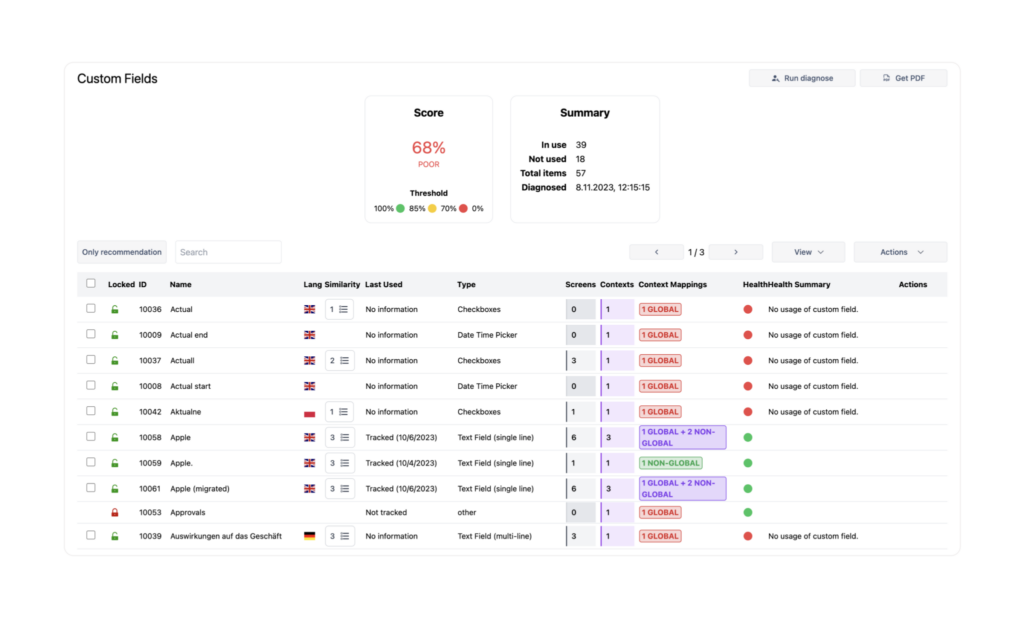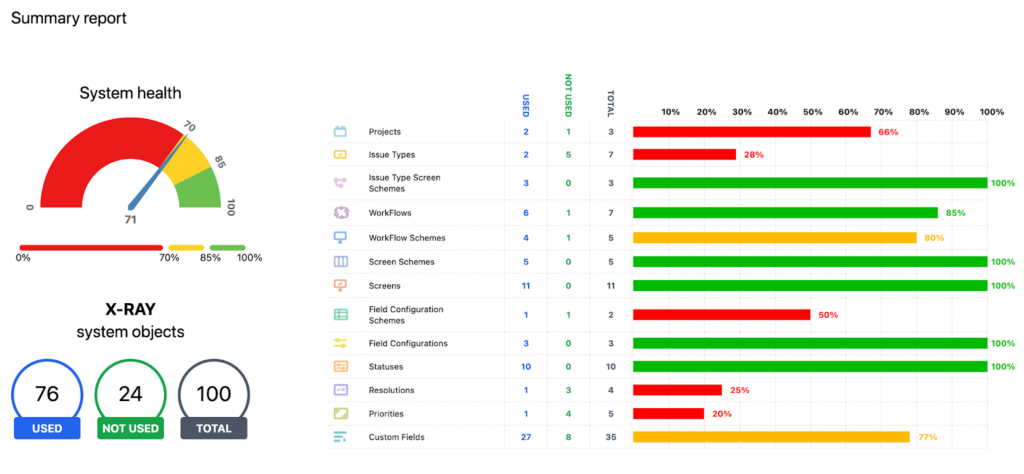For Jira admins seeking to elevate their management game, incorporating established best practices is pivotal. This article will navigate through essential Jira admin best practices, highlighting how leveraging Doctor for Jira can revolutionize these approaches.
Starting with the key challenges faced by Jira administrators, we’ll delve into the details of each best practice.
1. Efficiently manage custom fields in the Jira environment
Regularly removing unused custom fields is among the essential Jira admin best practices for maintaining optimal performance. This process involves eliminating fields that are no longer needed. This practice can significantly increase the responsiveness and usability of Jira. However, it is worth remembering that custom fields with non-standard types can affect performance in other ways.
Keep your Jira instance clean and tidy
Doctor Pro for Jira works as a comprehensive Jira system health monitor, offering a customized solution to boost system performance, which is especially important for custom fields and helps users keep their Jira environment at its highest performance.
By assessing the health of the system, you get a clear picture of how smoothly the Jira configuration is running. You also receive information about potential problems, such as duplicate or unused objects.

2. Understanding Data Governance
Data governance encompasses all activities aimed at ensuring data security, privacy, accuracy, availability, and usability. It comprises the actions individuals must undertake, the processes they must adhere to, and the technology that facilitates these efforts throughout the data lifecycle.
The Essence of Data Governance
Governance in this context entails the continuous assessment and management of control over Jira’s configurations, with the ultimate goal of ensuring its optimal performance and sustainability over the long term.
Without Data Governance:
- Clutter: Without proper governance, Jira can become disorganized, making it challenging for users to navigate.
- Confusing Fields: Uncontrolled field customizations can lead to confusion and usability issues.
- Unexpected Search Results: The absence of control can result in consistent and predictable search outcomes.
- Performance Issues: Unregulated data can negatively impact system performance.
- Frustrated End-Users: Lack of structure and clear rules can lead to end-users’ frustration.
- Tired Administrators: Administrators may face increased challenges and tasks, leading to exhaustion.
With Effective Data Governance:
- A cleaner and organized tool: Effective governance makes the tool more transparent and well-organized.
- Quicker, more precise search results: Effective management leads to faster, more accurate, and relevant search results.
- Highly efficient teams and admins: Effective governance results in more productive teams and content administrators who are satisfied with efficient workflows.
Automation is a game-changer when it comes to efficient data governance. Enter Doctor Pro for Jira, an AI-powered ally dedicated to enhancing your data governance practices. By leveraging the capabilities of Data Mining, AI, and Machine Learning, this remarkable tool takes on the role of a proactive assistant, catering to your unique data governance requirements.
3. Implementing Jira Admin Best Practices for Cloud Migration: Preparing Your Checklist with Automation
Effective planning is essential for successful cloud migration, enabling seamless collaboration, optimizing enterprise apps, and ensuring security. A smooth migration needs meticulous planning and execution.
Pre-Migration Preparation
Assessment and Planning
- Evaluate the current Jira setup and configuration.
- Determine the scope of the migration (projects, issues, workflows, users, etc.).
- Identify any customizations or integrations that need to be migrated.
Backup and Data Export
- Back up all data from the current Jira instance.
- Export projects, issues, attachments, and configurations.
User Communication
- Inform users about the upcoming migration and any potential disruptions.
- Provide resources for users to learn about the changes.
Configuration and Customizations – best practice
Evaluate Add-ons and Integrations
- Identify installed add-ons and integrations and check their compatibility with Jira Cloud.
- Determine whether similar functionality is available in the Cloud version.
Recreate Workflows and Schemes
- Rebuild workflows, issue types, and issue type schemes in Jira Cloud.
- Adjust permissions and notification schemes as needed.
Custom Fields and Screen Configuration
- Review custom fields and recreate them in Jira Cloud.
- Adjust screen layouts to match the requirements.
Doctor Pro for Jira is a powerful app designed to act as your proactive assistant, leading you on a seamless journey to achieve a pristine and optimized Jira environment. The full checklist you can check here.
4. 3 Steps to Prepare for Cleanup in Jira After Migration
Prepare for the clean up Jira
Before embarking on cleaning up your Jira instance after migration, it’s essential to be well-prepared. Begin with these initial steps:
Backing up your Jira instance
This step is of paramount importance. It serves as a safety net, safeguarding your valuable data and configurations. In case any unintended errors or missteps occur during the cleanup process, having a backup ensures that you can easily revert to the previous state without losing any critical information.
Gathering comprehensive information
Understanding your Jira’s current state is key. By taking inventory of projects, issues, users, custom fields, and instance performance, you gain valuable insights into areas that require attention. This information empowers you to make informed decisions during the cleanup, ensuring that your efforts target the most relevant and impactful elements.
Determining cleanup goals for Jira administrator
Defining cleanup goals maintains focus. Whether your aim is to remove old projects, eliminate unused issues, disable inactive users, or optimize project structures, setting clear goals helps prioritize tasks.
Start clean up Jira
When cleaning Jira, break tasks into categories for easier management. This helps with initial intimidation, especially for larger instances.
Atlassian recommends a systematic order for your cleanup:
Projects
Begin by identifying and archiving stale projects. Archiving preserves data while still delivering query results and reindexing improvements.
Issues
Similarly, search for opportunities to archive outdated issues. Archiving ensures data retention while effectively “moving it out of the way.”
Custom Fields
Identify and remove any custom fields that are no longer in use. Additionally, optimize performance by adjusting custom fields with a “global” context to specific projects.
Inactive Users
While removing users who have left your organization is essential, it’s prudent to double-check for any oversight. Utilize last login dates to avoid ticket assignments and free up licenses.
Alongside Atlassian’s recommendations, review other areas for unused elements across projects, including workflows, workflow schemes, screens, screen schemes, issue types, issue type schemes, and permission schemes. Eliminate any completely unused components, and consider consolidating duplicates to simplify project configuration for administrators.
By methodically approaching the cleanup through these categorized steps, you can effectively declutter your Jira instance, optimize its performance, and ensure a more streamlined and efficient project management experience.
Update your Jira instance regularly
Update your Jira instance regularly to make sure it is up-to-date and working properly. You can do this by enabling automatic updates or by installing updates manually.
Cleaning Jira instances after migration is crucial, but can be a daunting task. With Doctor for Jira, this process becomes easier and more efficient. You’ll quickly check the health of your configuration. With help comes a usability report that shows improvements with percentages, making it easy to understand and take action.

5. Leveraging Task Automation
Jira offers a wide array of automation features that can significantly save time and effort. Take advantage of these capabilities to automate tasks such as assignments, progress tracking, and notifications. Automation streamlines your workflow and reduces the likelihood of errors.
For instance, you can automate task assignments based on team members’ roles or skills. Progress tracking can also be automated based on completion dates or task status. Additionally, you can automate notifications to keep team members informed about changes in tasks.
6. Monitor system health
Monitoring your Jira instance’s system health, focusing on memory usage, CPU utilization, and disk space, is a crucial aspect of Jira admin best practices. This can help you proactively identify and address potential issues before they become major problems.
Monitoring the system health of your Jira instance is crucial for maintaining optimal performance. By regularly checking your system’s memory usage, CPU utilization, and disk space, you can quickly identify potential bottlenecks and take corrective action before they impact your users.
Implement system health checks and alerts for threshold notifications. Regularly review system logs to identify errors or warnings. Stay proactive for smooth and efficient Jira operation.
Conclusion
Embracing Jira admin best practices, especially with tools like Doctor Pro for Jira is essential for enhancing platform management.
These strategies collectively contribute to a more efficient, secure, and user-friendly Jira environment, underscoring the importance of continuous improvement and proactive management for administrators aiming for excellence.


